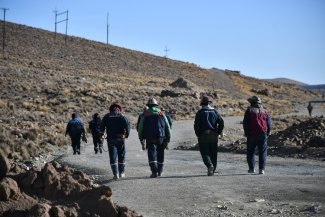The A-bomb explosion over the island of Mururoa, on 2 July 1966, was the first of a series of explosions of tactical bombs that the French Army tested in the Pacific Ocean.
“We had to wait inside the shelters until the rain passed,” says Daniel, a local farmer from Mangareva, one of the French Polynesian islands in the Gambier Archipelago, 1,500 kilometres south-east of Tahiti. He describes the drill carried out by French military officers for the island’s 500 residents on 24 August 1968, the day Canopus – a thermonuclear device 150 times stronger than those that destroyed Hiroshima and Nagasaki in August 1945 – went off 400km away.
This was neither the first nor the last time islanders would seek shelter when it rained. Between 1966 and 1996, France conducted 193 nuclear tests in what was then the Overseas Territory of French Polynesia. Forty-six tests were carried out in the atmosphere, the blasts producing radioactive clouds that floated with the winds, depositing radionuclides all over the environment and exposing people, fauna and flora to abnormal levels of irradiation.
For years, the true impact of nuclear testing in French Polynesia – these days a French Overseas Collectivity of 118 islands and atolls that spread across more than 2000km of Pacific waters – was kept a closely-guarded secret. Even to this day, all information about exposure levels is protected by the French military. But recently, the full extent of the fallout has slowly begun to come to light, and earlier this month, French Polynesian opposition politician Oscar Temaru told a United Nations meeting in New York that a complaint had been filed against France for ‘crimes against humanity’ in the International Criminal Court on behalf of “all the people who died from the consequences of nuclear colonialism”.
For the roughly 126,000 military personnel and civilians estimated to have had direct contact with residual radioactive materials from the tests, potential health impacts such as various cancers.
Due to poor infrastructure and a lack of access, many cases in Polynesia remained unreported for a long time and until 2009, most cancer patients were evacuated either to New Zealand of France for radiation therapy. Data released by the French Polynesian Ministry of Health earlier this year shows a steady increase in the number of radiation-induced diseases, with 93 new cancer cases reported in 1992 compared to 467 in 2017.
It could be said that the increase is the logical outcome of a more developed health care system, and more specific studies are certainly needed to assert precisely how the tests impact people’s health, but local communities refuse to believe this uptick in cancer diagnoses is a mere coincidence.
France, which is currently the world’s second-biggest nuclear electricity producer, has been pursuing a path towards nuclear power since 1939, primarily as a means of energy production, although it was also motivated by the desire to re-establish itself on the world stage. After the end of the Second World War, then president General Charles de Gaulle created the official French Atomic Energy Commission (Commissariat à l’énergie Atomique et aux énergies alternatives, or CEA). From 1956, Prime Minister Pierre Mendès-France began to manufacture atomic weapons, and on returning to power in 1958, de Gaulle activated a nuclear testing programme which resulted in the detonation of the first bomb in the Algerian desert on 13 February 1960 – the infamous Gerboise Bleue.
France carried out scores of both atmospheric and underground tests in Algeria, but when the country won its independence in 1962 after a brutal, seven-year war of independence, the CEA shifted its gaze towards France’s overseas territories in the Pacific. They chose the French Polynesian atolls of Moruroa and Fangataufa (part of the Tuamotu Archipelago) as its new testing grounds, and in May 1963, 300 personnel docked on Moruroa to build the first facilities of the Centre d’Expérimentations Nucléaires du Pacifique (CEP). Its impact was, in so many ways, lamentable.
Polynesian society left completely shaken
As Patrice Bouveret of the Observatoire des armements (Armaments Observatory), an independent organisation that has been assessing the impacts of French nuclear testing in Polynesia since 1984, tells Equal Times: “The decision of the French government to use the Polynesian territory as a site for its nuclear tests – having been forced to abandon the Saharan territory – completely shook, and in an extremely short period of time, the whole of Polynesia’s way of life at an economic, social, food, cultural and environmental level.”
Even before the bombs began to drop, the first efforts to simply construct the CEP sparked a wave of change that Polynesians hadn’t consented to and weren’t ready to deal with. “The Polynesian population was around 150,000 when more than 10,000 people – mostly single, young men – landed in the late 1960s. This led to a real explosion of consumption, real estate and land transactions, which benefited some Polynesians, but also aggravated inequalities,” explains Bouveret.
As a consequence, Tahiti experienced an almost three-fold increase in its population between 1962 and 1988. Such rampant urbanisation fuelled social inequalities. In addition, with a colonial economy that relied heavily on assistance from France, Polynesia experienced a pseudo-economic boom, where the rapid demand for labour, high salaries and the introduction of European-style capitalism lured people away from their traditional means of subsistence, such as fishing and production of copra, vanilla, and coffee for export. “At a societal level, upheavals were present in the development of significant ‘corruption’, a clientelism derived from this ‘nuclear rent’, the effects of which are still seen today with the multitude of court cases against Gaston Flosse,” say Bouveret, referring to the former president of Polynesia towards the end of nuclear testing period.
The CEP also left the landscape of some previously pristine islands and atolls across Polynesia unrecognisable. For example, more than two million cubic metres of land was excavated, while 2000 metres of waterfront was erected in over just two years of constructing the CEP. Uninhabited Moruroa became home to a 2000 metre airstrip and housing units for over 2000 personnel, while partially-leased Hao waved goodbye to 50,000 cubic metres of coral for access channels.
Once the tests began in 1966, the impacts turned towards the health of the local environment, the local inhabitants and the thousands of migrant workers, who were “poorly briefed” on the potential consequences of radiation by the state.
Aldebaran, the very first bomb detonated on 2 July 1966 above Moruroa, had its radioactive cloud pushed all the way to Mangareva, prompting the evacuation of the French Overseas Minister while locals remained in the dark.
Over 40 years later, a report by Observatoire des armements, showed previously classified documents featuring records by technicians from the Service Mixte de Controle Biologique (SMBC) – a body created by the CEA to collect and analyse biological samples during and after explosions – in which the amounts of radiation found in unwashed salad four days after Aldebaran were 666 times the regular amount. Drinking water presented six times more radioactive activity than usual, while the examined soil carried 50 times more radiation than normal. Almost three months later, a survey indicated that the levels of radioactivity found in the rain in Mangareva to be an astonishing 11 million times higher than expected.
Despite having such information at hand, the CEP carried on with the nuclear tests until President Jacques Chirac permanently ceased all experiments in February 1996.
The long fight for justice
After years of fighting for recognition in the face of staunch denials of responsibility from the French state, Polynesians finally experienced a flicker of hope in 2010, when the French government implemented a law to provide compensation for the victims of French nuclear testing in Polynesia. However, in many ways, the Morin Law has created more controversy than it has proper restitution.
According to the Comité d’indemnisation des victimes des essais nucléaires (the Committee for the Compensation of Nuclear Test Victims, or CIVEN), of the 1245 cases registered since the committee’s establishment, only 147 have come from the Polynesian population. So far, only 11 cases have been approved for compensation.
The questionable efficacy of the Morin Law often relates to the secrecy with which the French Defence Ministry carries out nuclear-related inquiries: no access to files means no possibility for thorough research, thus no prospect of fair, effective and comprehensive compensation.
This information blockade has also had tangible consequences on scientific findings – something that Dr Florent de Vathaire from the Radiation Epidemiology Group at the French National Institute of Health and Medical Research (INSERM) described in his 2010 study on the cases of thyroid cancer in French Polynesia as “limited exposure data.”
“The dosimetry data on which individual dosimetric reconstructions of the article published in 2010 were based, came from reports sent by France to the United Nations after each shooting campaign. Given the political context of the time, the data was necessarily simplified,” Vathaire tells Equal Times.
Despite ongoing efforts by Polynesian authorities to access documents, France still keeps most of them classified, which further increases the frustration of the Polynesians.
“Obviously, we will never have access to all the elements that could reveal, if only partially, the means to manufacture of the weapon,” says Yolande Vernaudon, from the Délégation Polynésienne pour le Suivi des Conséquences des Essais Nucléaires (DSCEN), an administrative service set up by the French Polynesian government to oversee processes related to the testing. However, she also argues that: “Some reports are classified ‘secret defence’ and whereas it seems to us that they contain no index of manufacture, they are important to enable us to trace the historical events.”
But beyond assessing the true extent of health impacts on the Polynesian population, a naked look into military documents could shine a light into other – perhaps even deeper – consequences from the nuclear period. “These last years, the focus has been mainly on the real but also supposed or even fantasised health impacts of these tests, obscuring the environmental, social and cultural impacts," Vernaudon tells Equal Times.
While France continues to neglect its responsibility, Polynesians have gathered a committee to discuss the creation of a memorial centre where archives, documents and personal testimonies will be displayed for generations to come.
“We are now preparing the specifications to recruit, by tender, a programmer scenographer who will be in charge of writing the draft detailed technical program that will allow consultation of project management,” said Vernaudon after the committee’s last meeting on 20 July 2018.
She adds that the centre has been requested by Polynesians for more than 15 years and although its content is not yet fixed, these first steps represent a new, pluralistic search for the truth.










